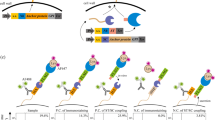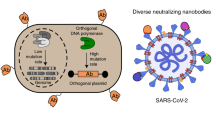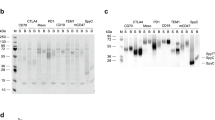Abstract
Display on the yeast cell wall is well suited for engineering mammalian cell-surface and secreted proteins (e.g., antibodies, receptors, cytokines) that require endoplasmic reticulum-specif ic post-translational processing for efficient folding and activity. C-terminal fusion to the Aga2p mating adhesion receptor of Saccharomyces cerevisiae has been used for the selection of scFv antibody fragments with threefold decreased antigen dissociation rate from a randomly mutated library. A eukaryotic host should alleviate expression biases present in bacterially propagated combinatorial libraries. Quantitative flow cytometric analysis enables fine discrimination of kinetic parameters for protein binding to soluble ligands.
This is a preview of subscription content, access via your institution
Access options
Subscribe to this journal
Receive 12 print issues and online access
$209.00 per year
only $17.42 per issue
Buy this article
- Purchase on Springer Link
- Instant access to full article PDF
Prices may be subject to local taxes which are calculated during checkout
Similar content being viewed by others
References
Smith, G.R. 1985. Filamentous fusion phage: novel expression vectors that display cloned antigens on the virion surface. Science 228: 1315–1317.
Burton, D.R. 1993. Monoclonal antibodies from combinatorial libraries. Acc. Chem. Res. 26: 405–411.
Winter, G., Griffiths, A.D., Hawkins, R.E., and Hoogenboom, H.R. 1994. Making antibodies by phage display technology. Annu. Rev. Immunol. 12: 433–455.
Barbas, S.M. and Barbas, C.F. 1992. Filamentous phage display. Fibrinolysis 8: 245–252.
Griffiths, A.D., et al. 1994. Isolation of high affinity human antibodies directly from large synthetic repertoires. EMBO J. 13: 3245–3260.
Griffiths, A.D., et al. 1993. Human anti-self antibodies with high specificity from phage display libraries. EMBO J. 12: 725–734.
Schlom, J., et al. 1992. Therapeutic advantage of high-affinity anticarcinoma radioimmunoconjugates. Cancer Res. 52: 1067–1072.
Schier, R., et al. 1996. Isolation of high-affinity monomeric human anti-c-enbB-2 single chain Fv using affinity-driven selection. J. Mol. Biol. 255: 28–43.
Hawkins, R.E., Russell, S.J., and Winter, G. 1992. Selection of phage antibodies by binding affinity: mimicking affinity maturation. J. Md. Biol. 226: 889–896.
Hawkins, R.E., Russell, S.J., Baier, M., and Winter, G. 1993. The contribution of contact and non-contact residues of antibody in the affinity of binding to antigen: the interaction of mutant D1.3 antibodies with lysozyme. J. Mol. Biol. 234: 958–964.
Ulrich, H.D., Patten, P.A., Yang, P.L., Romesberg, F.E., and Schultz, P.G. 1995. Expression studies of catalytic antibodies. Proc. Natl. Acad. Sci. USA 92: 11907–11911.
Vaughan, T.J., et al. 1996. Human antibodies with sub-nanomdar affinities isolated from a large non-immunized phage display library. Nature Biotechnology 14: 309–314.
Deng, S.J., et al. 1995. Basis for selection of improved carbohydrate-binding single-chain antibodies from synthetic gene libraries. Proc. Natl. Acad. Sci. USA 92: 4992–4996.
Hockney, R.C. 1994. Recent developments in heterologous protein production in Escherichia coli. Trends Biotechnol. 12: 456–463.
Georgiou, G., Stathopoulos, C., Daugherty, P.S., Nayak, A.R., Iverson, B.L., and Curtiss, R. III. 1997. Display of heterologous proteins on the surface of microorganisms: from the screening of combinatorial libraries to live recom-binant vaccines. Nature Biotechnology 15: 29–34.
Francisco, J.A., Campbell, R., Iverson, B.L., and Georgiou, G. 1993. Production and fluorescence-activated cell sorting of Escherichia coli expressing a functional antibody fragment on the external surface. Proc. Natl. Acad. Sci. USA 90: 10444–10448.
Kretzschmar, T., Zimmerman, C., and Geiser, M. 1995. Selection procedures for nonmatured phage antibodies: a quantitative comparison and optimization strategies. Anal. Biochem. 224: 413–419.
Phizicky, E.M. and Fields, S. 1995. Protein-protein interactions—methods for detection and analysis. Microbio. Rev. 59: 94–123.
Lu, C.-F, Montijn, R.C., Brown, J.L., Klis, F., Kurjan, J., Bussey, H., et al. 1995. Glycosyl phosphatidylinositol-dependent cross-linking of alpha-agglutinin and beta 1,6-glucan in the Saccfiaromyces cerevisiae cell wall. J. Cell Biol. 128: 333–340.
Schreuder, M.P., Brekelmans, S., Van Den Ende, H., and Klis, F.M. 1993. Targeting of a heterologous protein to the cell wall of Saccharomyces cerevisiae. Yeast 9: 399–409.
Schreuder, M.P., Mooren, A.T.A., Toschka, H.Y, Verrips, C.T., and Klis, F.M. 1996. Immobilizing proteins on the surface of yeast cells. Trends Biotechnol. 14: 115–120.
Roy, A., Lu, C.F., Marykwas, D.L., Lipke, P.N., and Kurjan, J. 1991. Trie AGA1 product is involved in cell surface attachment of the Saccharomyces cerevisiae cell adhesion gly-coprotein a-agglutinin. Mol. Cell. Biol. 11: 4196–4206.
Cappellaro, C., Baldermann, C., Rachel, R., and Tanner, W. 1994. Mating type-specific cell-cell recognition of Saccnaromyces cerevisiae: cell wall attachment and active sites of a- and α-agglutinin. EMBO J. 13: 4737–4744.
Johnston, M. and Davis, R.W. 1984. Sequences that regulate the divergent GAL1-GAL10 promoter in Saccharomyces cerevisiae. Mol. Cell. Biol. 4: 1440–1448.
Low, N.M., Holliger, P., and Winter, G. 1996. Mimicking somatic hypermutation: affinity maturation of antibodies displayed on bacteriophage using a bacterial mutator strain. J. Mol. Biol. 260: 359–368.
Parekh, R.N., Forrester, K.J., and Wittrup, K.D. 1995. Multicopy overexpression of bovine pancreatic trypsin inhibitor saturates the protein folding and secretory capacity of Saccftaromyees cerevisiae. Protein Expr. Purif. 6: 537–545.
Gietz, R.D. and Sugino, A. 1988. New yeast-Eschericnia coli shuttle vectors constructed with in vitro mutagenized yeast genes lacking six-base pair restriction sites. Gene 74: 527–534.
Gietz, R.D. and Schiestl, R.H. 1996. Transforming yeast with DNA. Methods in Molecular and Cellular Biology. 5: 255–269.
Author information
Authors and Affiliations
Corresponding author
Rights and permissions
About this article
Cite this article
Boder, E., Wittrup, K. Yeast surface display for screening combinatorial polypeptide libraries. Nat Biotechnol 15, 553–557 (1997). https://doi.org/10.1038/nbt0697-553
Received:
Accepted:
Issue Date:
DOI: https://doi.org/10.1038/nbt0697-553
This article is cited by
-
Current advancements in B-cell receptor sequencing fast-track the development of synthetic antibodies
Molecular Biology Reports (2024)
-
Molecular Engineering of Interleukin-2 for Enhanced Therapeutic Activity in Autoimmune Diseases
BioDrugs (2024)
-
A fine-tuned yeast surface-display/secretion platform enables the rapid discovery of neutralizing antibodies against Clostridioides difficile toxins
Microbial Cell Factories (2023)
-
Evolution of protease activation and specificity via alpha-2-macroglobulin-mediated covalent capture
Nature Communications (2023)
-
Immunotherapy in hematologic malignancies: achievements, challenges and future prospects
Signal Transduction and Targeted Therapy (2023)



